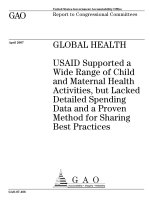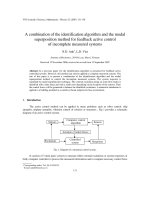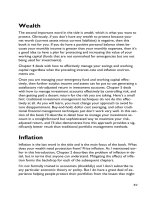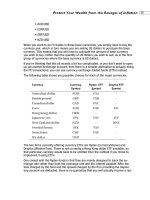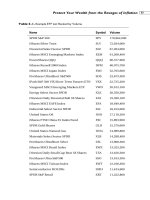everyone is a customer a proven method for measuring the value of every relationship in the era of collaborati phần 9 doc
Bạn đang xem bản rút gọn của tài liệu. Xem và tải ngay bản đầy đủ của tài liệu tại đây (356.39 KB, 24 trang )
❚ In many instances non-cash relationship currencies have
greater value than cash.
•You have to make assumptions about the specific curren-
cies you’ll need to achieve your goals.
•Acurrency has value only if you have it when needed.
•You must determine the time value of the currencies re-
ceived in the sense of whether they will appreciate or
depreciate over time.
• The value of a relationship currency is determined only
by the recipient of that currency.
•Arelationship currency may have to be combined with
other cash and non-cash currencies for it to be of value to
the recipient.
•You can use the relationship currencies you have (whether
yours to begin with or received from someone else) in
value propositions you establish with other parties.
❚ You can use the currencies received from someone else in
value propositions you establish with other parties.
•You can “bank” non-cash relationship currencies as you
are now able to measure and account for them.
•You may have to convert one relationship currency into
another before you can use it. These conversions may be
carried out with one or more people.
•You have to be careful to not overcommit the currencies
you are providing to others.
Given these guidelines, let’s look more closely at how you
use currencies to achieve your goals.
168 Part Two
❘
Purposeful Collaboration
RELATIONSHIP LINKAGE
As an example of how this process works, we’ll examine
one of our own experiences mentioned in the preface. In January
2001, we were asked to deliver a keynote speech at the Delphi
Group’s Collaborative Commerce Summit held in June 2001. To
assist us in evaluating that speaking opportunity, we prepared a
Relationship Scorecard for the Delphi Group. As you can see in
Figure 9.1, we believed we could potentially receive, in addition
to any cash compensation, four non-cash currencies: (1) actual
validation as experts in collaborative business (as we would be
making a keynote speech); (2) access to potential customers (the
hundreds of attendees at the Summit); (3) information about
technology (collaborative commerce software solutions from at-
tendees and exhibitors); and (4) access to competencies (the tal-
ented people we would meet). As shown in the Relationship
Scorecard we prepared (Figure 9.2), the four goals we focused on
achieving by December 31, 2001, were related to our cash flow
requirements and our three core business processes: (1) cus-
9
❘
Using Relationship Currencies to Achieve Your Goals 169
FIGURE 9.1
❘
Anticipated Currencies from Collaborative Commerce Summit
170 Part Two
❘
Purposeful Collaboration
FIGURE 9.2
❘
Delphi Group Relationship Scorecard
tomer acquisition and retention (CA&R); (2) product and service
innovation (P&SI); and (3) customer fulfillment and service
(CF&S). We calculated Delphi’s Future Relationship Value (FRV)
to be 4.4. That is, based on our assumptions, we believed that the
value we would receive toward helping us achieve our goals for
2001 was 4.4. We then prioritized that value relative to the FRVs
we had calculated for other opportunities and made the decision
to accept the invitation to speak at the summit.
This decision led to an increase in the intensity of our rela-
tionship with Delphi as a result of our allocating more resources to
it. The reason we needed to allocate more resources was due to the
specific activities we had to carry out in preparing for our summit
presentation. These activities included several face-to-face meet-
ings, e-mail exchanges, and numerous telephone conversations
during the months leading up to the summit. In addition, we con-
ducted a focused research study on choreographers to augment
the information we wanted to present, and we worked with a
graphic designer on the visuals we’d use in our presentation. As
the time of the summit approached, we composed and sent a num-
ber of e-mail announcements publicizing our participation.
Because we are focusing on how to use currencies to
achieve goals, let’s now examine how we derived value from
the currencies we received from Delphi. In Figure 9.3, we’ve
laid out the 12-month timeline for 2001 and have identified both
the relationships developed as a result of our participation at
the summit and the currencies we believed we would receive
from those relationships. The currencies shown in Figure 9.3 are
what we thought we’d gain from those relationships (their fu-
ture value) as identified at the time we first met a particular per-
son. This analysis includes only the new relationships that
sprang directly from our presentation and attendance at the
summit. The currencies we received from Delphi and from the
other relationships were not all made available to us in our first
interactions. As noted in Chapter 8, you gain access to curren-
cies as relationships iterate through the different activity levels
9
❘
Using Relationship Currencies to Achieve Your Goals 171
172 Part Two
❘
Purposeful Collaboration
FIGURE 9.3
❘
Relationship Linkage Diagram, Delphi Group
of collaboration. Understanding this, we engaged in a number
of interactions with each of the relationships that came out of
our presentation and attendance at the summit. Some eventu-
ally resulted in helping us achieve our goals. Some did not.
(Please note: To protect the privacy of our business associates,
we are using generic business categories rather than naming
specific companies and individuals.)
Now let’s take a closer look at some of the relationships
shown in Figure 9.3.
BUILDING NEW RELATIONSHIPS
The first new relationship identified in Figure 9.3 was with
a managing principal of a West Coast consulting company. As
can be seen, it was our belief at the time that this relationship
could provide the following currencies: (1) access to the com-
pany’s intellectual property; (2) actual competencies of the man-
aging principal and other staff; (3) access to the company’s base
of consulting clients; and (4) the joint development of a new
product that would benefit our respective customer bases. It was
this fourth currency that we saw as the primary value accruing
from the relationship.
Directly below the consulting company, we listed two trade
publications that wrote about the ideas we presented and/or
based articles on an interview with us. Not only has one of these
publications subsequently asked us to write for their publication,
but representatives of two other trade publications that heard us
speak have also asked us to write for their online and offline mag-
azines and are listed as Trade Publications (3) and (4). Each of these
four trade publications has provided us with some combination of
the following currencies: (1) cash, (2) validation, and (3) customers
(their readers interested in learning about collaboration).
Let’s shift focus now to our relationship with the public re-
lations (PR) agency. Approximately two months after the sum-
9
❘
Using Relationship Currencies to Achieve Your Goals 173
mit, we received a telephone call from John, a vice president of
one of the largest public relations companies in the world. John
said that he had read about us in Trade Publication (1), and as
shown in Figure 9.3, he had also perused the program schedule
for the summit on the Delphi Group Web site and knew we had
given a keynote speech on collaborative business. He said he
was calling on behalf of a client, a major collaborative commerce
software vendor. John said he was assembling a “panel of ex-
perts” on collaborative business and asked if we would partici-
pate on the panel. After the telephone conversation, we prepared
a Relationship Scorecard for John, having first identified the cur-
rencies we thought we’d gain access to as a result of our partici-
pation: (1) validation (recognition as an expert on collaborative
business); (2) intellectual property (the knowledge coming out of
the panel); (3) cash (for participation on the panel); and (4) access
to customers (the software company and the PR agency’s other
clients).
In Figure 9.4, we calculated a Future Relationship Value of
5.2 for John at the agency, which was higher than the 4.4 value
we had calculated for Delphi in January. This means that de-
spite the fact that it was already mid-August, we believed that
the value of the currencies we’d receive from the PR agency was
greater than Delphi’s, even though we were almost two-thirds
through the year (thus leaving little time to make use of the cur-
rencies to realize our 2001 goals). After completing the score-
card, we decided to participate, taking into consideration not
only what we’d gain from our participation but also the impact
on our resources, as we knew preparing for the panel would re-
quire a number of resource-consuming activities. Remember,
there is always a give and get to a collaborative relationship.
In early October 2001, we participated in the panel discus-
sion. For us, it was a very interesting experience. Not only did we
meet and interact with several nationally known media person-
alities and business experts, but we also began a relationship
with the software company on whose behalf the event was orga-
174 Part Two
❘
Purposeful Collaboration
nized. In addition, as shown in Figure 9.3, one of the other pan-
elists, a senior vice president at a major research firm, has asked
us to present our work on measuring the value of relationships to
a group of his firm’s analysts.
9
❘
Using Relationship Currencies to Achieve Your Goals 175
FIGURE 9.4
❘
PR Agency Relationship Scorecard, August 2001
Again referring to Figure 9.3, you can see that we are build-
ing a relationship with the collaborative commerce vendor as a
result of our participation on the panel. As with the other rela-
tionships shown, we’ve identified the currencies we believe
we’ll access as we build our relationship over time.
Although we haven’t described every relationship in detail,
let’s move on and explore how we realized value from the cur-
rencies we accessed in all of these relationships.
VALUE REALIZED
As we’ve discussed throughout this book, the primary ben-
efit of purposeful collaboration is to allocate your resources to
those relationships that provide the currencies you need for
achieving your goals. Consequently, you must continuously
evaluate whether the currencies you have gained and used are in
fact enabling you to achieve what you want to accomplish. To do
this, you should compare the planned milestone against the ac-
tual level achieved, as shown in Figure 9.5. Having a planned
milestone requires that you also identify how a goal is to be mea-
sured (the M in S-M-A-R-T) when you set your goals. For exam-
ple, if your goal is to increase sales by 50 percent, then the metric
would be the actual increase in sales over the prior period.
However, if you are only monitoring the percentage in-
crease in sales, you’ll not be successful, as that metric represents
the results at the end of the sales process. What we believe is
more critical is to identify a simple predictive metric early in the
sales process that is as near to real-time data as possible. For ex-
ample, perhaps it’s the number of customer inquiries per day, or
the number of product demos conducted each week, or the
number of people who enter your store each hour. Bear in mind
the best metric may not be directly connected to the sales
process. For example, one of the best metrics for gauging sales in
a fast-food restaurant is the average length of time it takes to
176 Part Two
❘
Purposeful Collaboration
serve a customer. A manager doesn’t have to wait to see the
day’s sales to take action. As soon as he observes it is taking
longer to serve a customer than desired, he can quickly reshuffle
personnel to correct the situation.
❚ Identify a simple metric that is as near to real-time data as
possible.
Let’s take a closer look at this evaluation process. Recall
that in Figure 7.3 (Chapter 7), the example we presented identi-
fied as Goal 1 signing up five business clients who require busi-
ness planning, audit, and tax services. However, the reality is
9
❘
Using Relationship Currencies to Achieve Your Goals 177
FIGURE 9.5
❘
Evaluate Performance
you should not wait until the end of the goal achievement pe-
riod, which in this example is year-end 2003, to see if you signed
up the desired five new clients. Your information system should
provide the specific information you require so that you can as-
sess progress toward your goals at any time. Again, the metric is
not the number of clients already signed up but something oc-
curring much earlier in the process, such as the number of meet-
ings you have with prospects.
One of the primary benefits of using the Relationship Score-
card is that it provides you with a real-time indication of whether
you are making progress toward your goals. By using it to record
the currencies you are receiving on an interaction-by-interaction
basis, you’ll always know if you are gaining access to the desired
currencies when you need them. If you aren’t getting what you
need when you need it, you aren’t making progress. Thus, if a
person’s current relationship value doesn’t increase after an in-
teraction with that person, you haven’t received additional cur-
rencies and thus haven’t made progress toward the goals those
currencies are supposed to help you achieve. By using currencies
to monitor your progress on a real-time basis, you can iterate
how and to whom you’re allocating your resources as soon as
you sense that it’s necessary to make an adjustment. This rapid
assessment and subsequent adjustment increase the likelihood
you will accomplish your plans.
❚ If you aren’t getting the currencies you need when you need
them, you aren’t making progress.
The Relationship Scorecard helps you measure and manage
your relationships so that you can better reach your goals and
gain success. And the table in Figure 9.5 allows you to regularly
monitor your progress toward the milestone you’ve established
for each goal. Essentially, this evaluation is best thought of as
that step in the iterative process we call analysis and refinement.
178 Part Two
❘
Purposeful Collaboration
You use our analytical tools and your information system to pro-
vide you with real-time data, and then based on your ability to
“see the patterns” where and when necessary, you refine your
actions to gain the currencies and achieve your goals.
❚ Rapid assessment and subsequent adjustment increase
the likelihood you will accomplish your planned level of
achievement.
Given this understanding, let’s take a look at the value we
realized from our initial decision to accept Delphi’s offer. (This
analysis does not include our use of currencies received from
these new relationships with people known prior to the summit.
As such, the listing does not include all of the value we realized
from our presentation and attendance.) As of December 31, 2001,
Delphi Group and the 12 other people/companies with whom
we’ve established relationships have provided the following
value:
• Seven bylined articles published
• Three articles written about us
•Two relationships developed with people who add sig-
nificant competencies to our community
• Cash compensation in excess of five times cash expended
•Abylined article placed in a major business publication
by the PR agency
• An initial assignment with the software vendor
•Apresentation to a major research firm
• References to us and quotes from us in numerous publi-
cations as experts in collaborative business
9
❘
Using Relationship Currencies to Achieve Your Goals 179
Clearly, the above items added significantly toward the
achievement of our goals for 2001. But that’s not the whole story.
In addition to our relationship with the Delphi Group, we now
have 12 new relationships (members) in our community and can
assess the value of their currencies relative to helping us achieve
our goals for 2002. So, like the Energizer Bunny, the process
keeps on going and going and going.
Figure 9.6 is the scorecard for our association with the PR
agency as of early January 2002 in relation to our new goal pri-
orities for the year. As you can see, not only have we changed the
weighting on each goal, but we felt that we could access addi-
tional relationship currencies from the PR agency, resulting in a
new Future Relationship Value of 7.45. The reason we felt we
would gain access to additional currencies was because of the
value of the currencies we have already received (thus closing
the Delta) as we’ve iterated our relationship with John through
the first two levels of collaboration (shown in Figure 9.7). As we
write this book, we are just starting to work together at the co-
creation of value level, as we’re helping John implement the Re-
lationship Scorecard process in his dealings with his customers.
We think it will be an important tool for him to demonstrate to
customers the value his services bring, and it will help us create
a new product.
PUTTING IT ALL TOGETHER
Thus, using relationship currencies to help you achieve
goals is really a process of recognizing the value of non-cash
currencies and the categories they fall into, such as access to in-
tellectual property, information about customers, and so forth.
Then, by evaluating your relationships and the currencies they
bring, you put in place purposeful value propositions with spe-
cific members of your community and work diligently to use
those currencies to achieve your goals. This last point may seem
180 Part Two
❘
Purposeful Collaboration
obvious, but we don’t know how many times businesspeople
fail to take advantage of relationship currencies. For example,
businesspeople agree to give a speech and then fail to network
after the speech, have articles placed for them but aren’t ready
9
❘
Using Relationship Currencies to Achieve Your Goals 181
FIGURE 9.6
❘
PR Agency Relationship Scorecard, January 2002
to exploit the publicity, and/or gain access to a potential client
but fail to impress the client. In short, non-cash currencies only
make sense if you can take advantage of a specific currency.
An offer that allows you to network is worth nothing if you
are a poor networker. Publicity is of no value if you don’t take ad-
vantage of the publicity. An interview with a valuable client is a
mistake unless you are prepared to impress the client. Therefore,
when evaluating which non-cash currencies offer the most poten-
tial at any particular point, you must take into consideration your
own and your company’s strengths and weaknesses. Then, if you
182 Part Two
❘
Purposeful Collaboration
FIGURE 9.7
❘
PR Agency Levels of Collaboration, January 2002
'
decide to go ahead based on receiving the relationship currencies,
you must follow up that decision by working hard to transform
that currency into what you need to achieve your goals.
We hope this discussion has not only provided you with a
better understanding of how to use non-cash currencies but has
also shown you how to utilize all your currencies when negotiat-
ing with other parties. After all, once you understand the value of
relationship currencies and how to evaluate them for yourself,
it’s easy to see how your currencies might be of value to others
and how best to present them.
Like many things in business, it may take some practice to
use the processes and tools discussed in this chapter (and
throughout the book) before they become second nature to you.
However, the return on the investment will be significant. Not
only will you build collaborative relationships but for the very
first time you can effectively focus your resources on those rela-
tionships that provide you the greatest strategic benefit.
WHAT HAVE WE LEARNED?
1 ❚ Below are ten guidelines for using non-cash relationship currencies
to achieve your goals:
• You do not have to convert all non-cash relationship currencies
into cash because in many instances non-cash currencies have
greater value than cash.
• You have to make assumptions about the specific currencies you’ll
need to achieve your goals.
• A currency has value only if you have it when needed.
• You have to determine the time value of the currencies received in
the sense of whether they will appreciate or depreciate over time.
9
❘
Using Relationship Currencies to Achieve Your Goals 183
• The value of a relationship currency is determined only by the re-
cipient of that currency.
• A relationship currency may have to be combined with other cash
and non-cash currencies to be of value to the recipient.
• You can use the relationship currencies you have (whether they’re
yours to begin with or received from someone else) in value propo-
sitions you establish with other parties.
• You can “bank” non-cash relationship currencies, as you are now
able to account for them.
• You may have to convert one relationship currency into another
before you can use it. Such conversions may be carried out with
one or more people.
• You have to be careful to not overcommit the currencies you are
providing to others.
2 ❚ Continually evaluate whether the currencies you have gained and
used are in fact enabling you to achieve what you want by compar-
ing the planned milestone against the actual level achieved.
3 ❚ We believe it is critical to identify a simple metric early on in the process
you are monitoring that is as near to real-time data as possible.
4 ❚ By using the Relationship Scorecard to record the currencies you are
receiving on an interaction-by-interaction basis, you’ll always know if
you are gaining access to the desired currencies when you need
them. If you aren’t getting what you need when you need it, you
aren’t making progress.
5 ❚ By monitoring your progress on a real-time basis,you can iterate how
you’re allocating your resources as soon as you sense that it’s neces-
sary. This rapid assessment and adjustment increase the likelihood
you will accomplish your planned level of achievements.
184 Part Two
❘
Purposeful Collaboration
6 ❚ Using currencies to help you achieve goals is really a process of rec-
ognizing the value of non-cash currencies and the categories they fall
into, such as access to intellectual property, information about cus-
tomers, and so forth. Then, by evaluating relationships and the cur-
rencies they bring, you put in place purposeful value propositions
with specific members of your community and work diligently to use
these currencies to achieve your goals.You analyze the results, make
new assumptions, and start the process again.
9
❘
Using Relationship Currencies to Achieve Your Goals 185
Your Success
PART THREE
188 Part One
❘
Part Title
ARE YOU READY TO COLLABORATE?
Is your company ready to collaborate? Are you? The knowl-
edge and understanding gained by reading this book, we hope,
has prepared you for our readiness check for collaborative busi-
ness. Be honest with yourself as you answer these ten important
questions:
YES NO
1. Are you ready to look at every relationship
as a customer relationship? _____ _____
2. Are you ready to allocate your resources to
those relationships that provide the greatest
strategic value? _____ _____
3. Are you ready to put in place a company
structure, compensation system, and culture
that foster internal and external collaboration? _____ _____
189
How You Do Business in
the Era of Collaborative
Business
CHAPTER 10
4. Are you ready to engage your customers and
business partners in the design, development,
and delivery of the market basket of goods and
services intended to satisfy your customers? _____ _____
5. Are you ready to measure and manage the
relationships that comprise your community
and underlie your day-to-day activities? _____ _____
6. Are you ready to systematically track the
individual interactions you have with your
customers and business partners? _____ _____
7. Are you ready to effectively utilize non-cash
relationship currencies in your dealings with
customers and business partners? _____ _____
8. Are you ready to systematically value,
measure, and manage currencies other
than cash? _____ _____
9. Are you ready to get the right information to
the right person at the right time? _____ _____
10. Are you ready to assess whether to iterate
each relationship after every interaction? _____ _____
It is our belief that if you answered no to any of our ques-
tions, you need to understand why and then identify a plan of
action to answer the question with a yes. Until you can answer
yes to every question, you will not realize all the benefits of col-
laborative business.
THE FUNDAMENTAL QUESTION
When we undertook the challenge of writing this book, we
knew it would require our looking at relationships from many
190 Part Three
❘
Choreographing Your Success
perspectives. We knew that to accurately describe the signifi-
cance of relationships in the era of collaborative business, we
had to describe the big picture. We had to describe how to value
relationships on a macro level—from a company’s perspective.
And at the same time we knew what we were describing was
such a profound change from the prevailing mindset that we
also had to describe how to value relationships on a micro
level—up close and personal.
We’ve discussed how we draw a distinction between the
macro and micro views of relationships because even though
people think about the relationships their company has on a
company-to-company basis, relationships actually exist on a
person-to-person basis. In light of this reality, we have tried to
provide the understanding and the tools to answer the question,
How do you do business in the era of collaborative business? on both
levels—the micro and the macro.
Before you start the dance, let’s take a few minutes to
quickly review the Purposeful Collaboration Process shown in
Figure 10.1. We start in the center of the figure because the tech-
nique of “Developing Understanding” underlies all nine com-
ponents of Purposeful Collaboration. Assumptions are your
beliefs based on your current level of understanding. As you
learn from putting your assumptions into practice and then
gathering, processing, and connecting new information, your
level of understanding improves, and you refine your ideas and
then make better assumptions. This iterative process of learning
is universal and needs to become an ingrained part of how you
do business.
❚ The technique of “Developing Understanding” underlies
all nine components of Purposeful Collaboration.
Now let’s look at each of the nine components of the Pur-
poseful Collaboration Process:
10
❘
How Yo u Do Business in the Era of Collaborative Business 191

